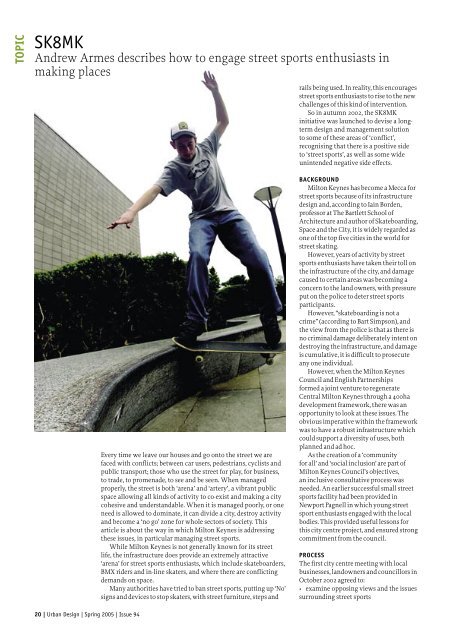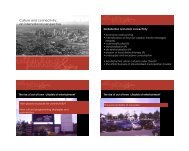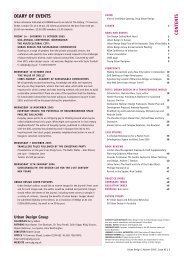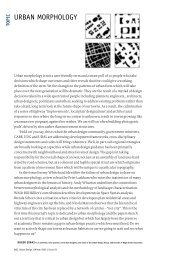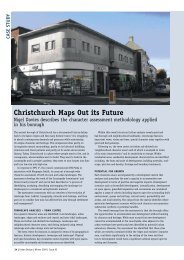CONTENTS DIARY OF EVENTS - The Urban Design Group
CONTENTS DIARY OF EVENTS - The Urban Design Group
CONTENTS DIARY OF EVENTS - The Urban Design Group
You also want an ePaper? Increase the reach of your titles
YUMPU automatically turns print PDFs into web optimized ePapers that Google loves.
TOPIC<br />
SK8MK<br />
Andrew Armes describes how to engage street sports enthusiasts in<br />
making places<br />
20 | <strong>Urban</strong> <strong>Design</strong> | Spring 2005 | Issue 94<br />
Every time we leave our houses and go onto the street we are<br />
faced with conflicts; between car users, pedestrians, cyclists and<br />
public transport; those who use the street for play, for business,<br />
to trade, to promenade, to see and be seen. When managed<br />
properly, the street is both ‘arena’ and ‘artery’, a vibrant public<br />
space allowing all kinds of activity to co-exist and making a city<br />
cohesive and understandable. When it is managed poorly, or one<br />
need is allowed to dominate, it can divide a city, destroy activity<br />
and become a ‘no go’ zone for whole sectors of society. This<br />
article is about the way in which Milton Keynes is addressing<br />
these issues, in particular managing street sports.<br />
While Milton Keynes is not generally known for its street<br />
life, the infrastructure does provide an extremely attractive<br />
‘arena’ for street sports enthusiasts, which include skateboarders,<br />
BMX riders and in-line skaters, and where there are conflicting<br />
demands on space.<br />
Many authorities have tried to ban street sports, putting up ‘No’<br />
signs and devices to stop skaters, with street furniture, steps and<br />
rails being used. In reality, this encourages<br />
street sports enthusiasts to rise to the new<br />
challenges of this kind of intervention.<br />
So in autumn 2002, the SK8MK<br />
initiative was launched to devise a longterm<br />
design and management solution<br />
to some of these areas of ‘conflict’,<br />
recognising that there is a positive side<br />
to ‘street sports’, as well as some wide<br />
unintended negative side effects.<br />
BACKGROUND<br />
Milton Keynes has become a Mecca for<br />
street sports because of its infrastructure<br />
design and, according to Iain Borden,<br />
professor at <strong>The</strong> Bartlett School of<br />
Architecture and author of Skateboarding,<br />
Space and the City, it is widely regarded as<br />
one of the top five cities in the world for<br />
street skating.<br />
However, years of activity by street<br />
sports enthusiasts have taken their toll on<br />
the infrastructure of the city, and damage<br />
caused to certain areas was becoming a<br />
concern to the land owners, with pressure<br />
put on the police to deter street sports<br />
participants.<br />
However, “skateboarding is not a<br />
crime” (according to Bart Simpson), and<br />
the view from the police is that as there is<br />
no criminal damage deliberately intent on<br />
destroying the infrastructure, and damage<br />
is cumulative, it is difficult to prosecute<br />
any one individual.<br />
However, when the Milton Keynes<br />
Council and English Partnerships<br />
formed a joint venture to regenerate<br />
Central Milton Keynes through a 400ha<br />
development framework, there was an<br />
opportunity to look at these issues. <strong>The</strong><br />
obvious imperative within the framework<br />
was to have a robust infrastructure which<br />
could support a diversity of uses, both<br />
planned and ad hoc.<br />
As the creation of a ‘community<br />
for all’ and ‘social inclusion’ are part of<br />
Milton Keynes Council’s objectives,<br />
an inclusive consultative process was<br />
needed. An earlier successful small street<br />
sports facility had been provided in<br />
Newport Pagnell in which young street<br />
sport enthusiasts engaged with the local<br />
bodies. This provided useful lessons for<br />
this city centre project, and ensured strong<br />
commitment from the council.<br />
PROCESS<br />
<strong>The</strong> first city centre meeting with local<br />
businesses, landowners and councillors in<br />
October 2002 agreed to:<br />
• examine opposing views and the issues<br />
surrounding street sports


